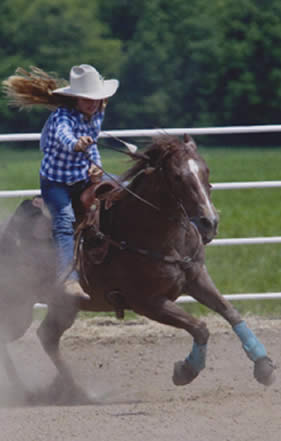
Horseytalk.net Special Interview
Chic
 Eye operation means Chic is now pain-free and back to her old self
Eye operation means Chic is now pain-free and back to her old self
After suffering repeated episodes of uveitis — an inflammation inside the eye — Chic lost sight in her left eye. Although partial blindness did not stop Chic from being ridden by the young girl who was her owner, the eye did cause the horse pain.
Dr. Ralph Hamor, a veterinary ophthalmologist at the University of Illinois Veterinary Teaching Hospital in Urbana, and his colleagues recently performed surgery that provided relief from Chic's painful eye.
"Equine recurrent uveitis is the most common reason horses go blind," said Dr. Hamor. "Sometimes the eye shrinks and the eyelids roll inward, a condition called entropion, which can be uncomfortable."
For Chic, the solution was enucleation, the surgical removal of the globe of the eye and the eyeball itself and the surrounding tissues. This procedure is most often performed when the eye is blind and painful, as in Chic's case.
Before Chic underwent enucleation, as with any surgery, Dr. Hamor and the staff of the hospital's equine medicine service performed a physical examination and tested her blood to ensure that the enucleation surgery could be safely performed.
An enucleation can be performed while the horse is sedated and standing in stocks. A regional anesthetic is used to block pain in the eye and surrounding tissues. Antibiotics and anti-inflammatory drugs are given just prior to surgery.
Dr. Hamor explains that there are two surgical approaches used for removing an eye.
"In the transconjunctival approach, the surgeon removes the globe by incising through the conjunctival tissues, cutting the extraocular muscles and the optic nerve and then removing all of the conjunctival tissues, the third eyelid and the eyelid margins," said Dr. Hamor. "The transpalpebral approach involves making an incision around the eyelids, then the extraocular muscles of the eye and optic nerve are cut, and everything, including the third eyelid, is removed at once within the conjunctival sac and eyelid margins."
An intraorbital prosthetic can be placed within the eye socket to make the shape of the horse's face look more normal; the eyelid margins are sewn shut, so the prosthetic is not seen. The prosthetic is a surgical ball made of silicone that keeps the empty eye socket from sinking in. Once the prosthetic is placed, the subcutaneous and subcuticular layers are sutured together, the skin incision is sewn shut and the surgery is complete.
After the surgery, Chic received anti-inflammatory drugs and antibiotics. Dr. Hamor advised Chic's owners that there might be mild swelling of the surgery site, as with any surgery. He told the owners to watch for any signs of a problem, such as excessive drainage and swelling. Chic would need to see a veterinarian if problems arose.
Once she was back home, Chic's owners continued giving their horse antibiotics and anti-inflammatories and kept the area of the surgery clean and dry. Dr. Hamor said that if horses begin rubbing at the surgical site, a fly mask can help protect it.
The sutures were removed about two weeks later, and Chic is now pain-free and back to her old self, riding in competitions with her girl.
With horses, Dr. Hamor said that it is important to keep in mind an adjustment period after surgery.
"Horses are prey species. Especially in cases where their change in vision comes about quickly, they will need some time to adapt," said Dr. Hamor.
Precautions should be taken while riding, since there is a potential for the animal to spook if they are no longer visual in both eyes.
"Although there is some concern, most horses, like Chic, do just fine," said Dr. Hamor.


